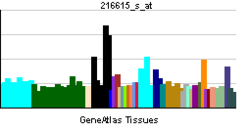HTR3A
| View/Edit Human | View/Edit Mouse |
5-hydroxytryptamine receptor 3A is a protein that in humans is encoded by the HTR3A gene.[4][5]
The product of this gene belongs to the ligand-gated ion channel receptor superfamily. This gene encodes subunit A of the type 3 receptor for 5-hydroxytryptamine (serotonin), a biogenic hormone that functions as a neurotransmitter, a hormone, and a mitogen. This receptor causes fast, depolarizing responses in neurons after activation. It appears that the heteromeric combination of A and B subunits is necessary to provide the full functional features of this receptor, since either subunit alone results in receptors with very low conductance and response amplitude. Alternatively spliced transcript variants encoding different isoforms have been identified.[6]
See also
References
- ↑ "Drugs that physically interact with 5-hydroxytryptamine receptor 3A view/edit references on wikidata".
- ↑ "Human PubMed Reference:".
- ↑ "Mouse PubMed Reference:".
- ↑ Weiss B, Mertz A, Schrock E, Koenen M, Rappold G (Feb 1996). "Assignment of a human homolog of the mouse Htr3 receptor gene to chromosome 11q23.1-q23.2". Genomics. 29 (1): 304–5. doi:10.1006/geno.1995.1254. PMID 8530095.
- ↑ Kelley SP, Dunlop JI, Kirkness EF, Lambert JJ, Peters JA (Jul 2003). "A cytoplasmic region determines single-channel conductance in 5-HT3 receptors". Nature. 424 (6946): 321–4. doi:10.1038/nature01788. PMID 12867984.
- ↑ "Entrez Gene: HTR3A 5-hydroxytryptamine (serotonin) receptor 3A".
Further reading
- Miyake A, Mochizuki S, Takemoto Y, Akuzawa S (1995). "Molecular cloning of human 5-hydroxytryptamine3 receptor: heterogeneity in distribution and function among species.". Mol. Pharmacol. 48 (3): 407–16. PMID 7565620.
- Uetz P, Abdelatty F, Villarroel A, et al. (1994). "Organisation of the murine 5-HT3 receptor gene and assignment to human chromosome 11.". FEBS Lett. 339 (3): 302–6. doi:10.1016/0014-5793(94)80435-4. PMID 8112471.
- Belelli D, Balcarek JM, Hope AG, et al. (1996). "Cloning and functional expression of a human 5-hydroxytryptamine type 3AS receptor subunit.". Mol. Pharmacol. 48 (6): 1054–62. PMID 8848005.
- Brüss M, Göthert M, Hayer M, Bönisch H (1999). "Molecular cloning of alternatively spliced human 5-HT3 receptor cDNAs.". Ann. N. Y. Acad. Sci. 861: 234–5. doi:10.1111/j.1749-6632.1998.tb10196.x. PMID 9928262.
- Davies PA, Pistis M, Hanna MC, et al. (1999). "The 5-HT3B subunit is a major determinant of serotonin-receptor function.". Nature. 397 (6717): 359–63. doi:10.1038/16941. PMID 9950429.
- Brüss M, Eucker T, Göthert M, Bönisch H (2000). "Exon-intron organization of the human 5-HT3A receptor gene.". Neuropharmacology. 39 (2): 308–15. doi:10.1016/S0028-3908(99)00116-1. PMID 10670426.
- Marazziti D, Betti L, Giannaccini G, et al. (2002). "Distribution of [3H]GR65630 binding in human brain postmortem.". Neurochem. Res. 26 (3): 187–90. doi:10.1023/A:1010939530412. PMID 11495540.
- Spier AD, Lummis SC (2003). "Immunological characterization of 5-HT3 receptor transmembrane topology.". J. Mol. Neurosci. 18 (3): 169–78. doi:10.1385/JMN:18:3:169. PMID 12059035.
- Boyd GW, Low P, Dunlop JI, et al. (2002). "Assembly and cell surface expression of homomeric and heteromeric 5-HT3 receptors: the role of oligomerization and chaperone proteins.". Mol. Cell. Neurosci. 21 (1): 38–50. doi:10.1006/mcne.2002.1160. PMID 12359150.
- Hapfelmeier G, Haseneder R, Lampadius K, et al. (2003). "Cloned human and murine serotonin(3A) receptors expressed in human embryonic kidney 293 cells display different single-channel kinetics.". Neurosci. Lett. 335 (1): 44–8. doi:10.1016/S0304-3940(02)01156-4. PMID 12457738.
- Strausberg RL, Feingold EA, Grouse LH, et al. (2003). "Generation and initial analysis of more than 15,000 full-length human and mouse cDNA sequences". Proc. Natl. Acad. Sci. U.S.A. 99 (26): 16899–903. doi:10.1073/pnas.242603899. PMC 139241
 . PMID 12477932.
. PMID 12477932. - Pick H, Preuss AK, Mayer M, et al. (2003). "Monitoring expression and clustering of the ionotropic 5HT3 receptor in plasma membranes of live biological cells". Biochemistry. 42 (4): 877–84. doi:10.1021/bi026576d. PMID 12549905.
- Choi S, Lee JH, Oh S, et al. (2003). "Effects of ginsenoside Rg2 on the 5-HT3A receptor-mediated ion current in Xenopus oocytes". Mol. Cells. 15 (1): 108–13. PMID 12661769.
- Boyd GW, Doward AI, Kirkness EF, et al. (2003). "Cell surface expression of 5-hydroxytryptamine type 3 receptors is controlled by an endoplasmic reticulum retention signal". J. Biol. Chem. 278 (30): 27681–7. doi:10.1074/jbc.M304938200. PMID 12750374.
- Sun H, Hu XQ, Moradel EM, et al. (2003). "Modulation of 5-HT3 receptor-mediated response and trafficking by activation of protein kinase C". J. Biol. Chem. 278 (36): 34150–7. doi:10.1074/jbc.M303584200. PMID 12791692.
- Maksay G, Bikádi Z, Simonyi M (2004). "Binding interactions of antagonists with 5-hydroxytryptamine3A receptor models". J. Recept. Signal Transduct. Res. 23 (2–3): 255–70. doi:10.1081/RRS-120025568. PMID 14626451.
- Kaiser R, Tremblay PB, Sezer O, et al. (2004). "Investigation of the association between 5-HT3A receptor gene polymorphisms and efficiency of antiemetic treatment with 5-HT3 receptor antagonists". Pharmacogenetics. 14 (5): 271–8. doi:10.1097/00008571-200405000-00001. PMID 15115912.
- Panicker S, Cruz H, Arrabit C, et al. (2004). "Minimal structural rearrangement of the cytoplasmic pore during activation of the 5-HT3A receptor". J. Biol. Chem. 279 (27): 28149–58. doi:10.1074/jbc.M403545200. PMID 15131114.
External links
- HTR3A protein, human at the US National Library of Medicine Medical Subject Headings (MeSH)
This article incorporates text from the United States National Library of Medicine, which is in the public domain.

